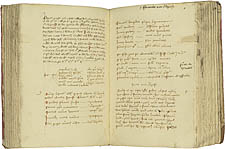Chapter and Verse
![]()
This notebook has tabs made of parchment strips to indicate where separate
texts begin. The leaves in the second half of the book have also been
numbered, and an impromptu table of contents or index in the front indicates
the folios where subjects and titles can be found. The page on the right
shows the Arabic numeral 7 in the top margin, indicating the folio; the
numeral looks rather like the Greek character lambda (l), but is an early
form of the number 7. (The number 69, penciled into the corner, is a recent
addition that indicates the number of the folio from the beginning of
the book.) Such features, appearing in a manuscript that was produced
a hundred years before printing, suggest that the impulse to organize
text for easier reference was already keenly felt. Printing was wonderfully
suited to satisfy that impulse.
![]()
Theological Miscellany. Germany, middle of the
fourteenth century.
![]()

Copyright
© 2002 Division of Rare & Manuscript
Collections
2B Carl A. Kroch Library, Cornell University, Ithaca, NY, 14853
Phone Number: (607) 255-3530. Fax Number: (607) 255-9524
For
reference questions, send mail to:
rareref@cornell.edu
If you have questions or comments about the site, send mail to: webmaster.
